Abstract
In recent decades, the creation and availability of Voluntary Geographic Information (VGI) have changed the paradigm associated with the production of Geospatial Information (GI), since, due to its free access, citizens can view, analyse, process, and validate this type of data. One of the most popular examples of VGI is the collaborative OpenStreetMap (OSM) project which covers a wide range of themes or characteristics associated with the real world. One of these themes is the feature “waterway” that represents watercourses. The quality of OSM data characteristics is a topic that has been published by many authors in recent years, particularly on the analysis of the completeness indicator. However, few references are found in the literature about studies that analyse the completeness of OSM watercourses or even watercourses obtained by other sources. All this motivated the authors to develop a study that aims to analyse the completeness of these specific lines that have so much relevance to hydrologists. The study presents an analysis of the variation over time in completeness/coverage of the OSM “waterway” feature in the period between 2014 and 2023 in a mountainous region included in the Mondego River basin, located in the Inland of Portugal. The methodology applied is supported by classical methods of measuring the completeness of lines that may be found in the literature. The total length of the watercourses was calculated and compared in percentage terms with the total length of the reference watercourses for dates under analysis. The watercourses of the military official hydrography of the 1/25,000 scale were used as a reference. The relation of the OSM completeness with some indicators related to terrain surface (altitude, slope, and location/proximity settlements) was also analysed. The choice of these indicators was motivated by the fact that the study area has strong mountain characteristics and is crossed by the main Portuguese river. The analysis was performed using the Shuttle Radar Topography Mission Digital Elevation Model (SRTM DEM) data and satellite image of Geographic Information System software. The results show that the completeness of this OSM feature (waterway) has a slight increase, considering the amplitude of the studied period (nine years) and the fact that, nowadays, digital mobile devices enable easy access to satellite images, allowing the digitalization of geographic entities or objects of the real world remotely. Regarding the indicator altitude, slope, and location/proximity of the settlements, we believe that there is no influence of these indicators on the evolution of the completeness of the OSM waterways in the study area.
1. Introduction
Recently, remotely sensed data have been extensively used for the mapping of water resources [1]. The amount and location of water on the Earth’s surface change over time and are influenced by natural processes and human activities [2]. The cartographic representation of watercourses is necessary for several hydrological studies, namely the morphometric basins characterization, useful in the domain of water resources management.
The topographic maps produced by cartographic agencies normally include the representation of watercourses. However, this theme feature is also included in the OpenStreetMap (OSM) database. OSM is a collaborative project that enables the creation and distribution of geospatial data from around the world, in vector format and with open access. It is designed to create and deliver geographic datasets based on contributions from voluntary citizens (e.g., [3]). It was founded in 2004 based on an idea launched by a master’s student, Steve Coast, which would later be included in his master’s thesis and which consisted of the following: if a citizen starts mapping the area where he lives, an area that he knows well, and if another citizen proceeds in the same way, then this idea can be extended to all citizens of the world and, in this way, it will be possible to map all of the world. Since then, OSM data have been used and applied in several studies located in different zones of the world and currently, the platform already has more than 10,000,000 registered volunteers (https://wiki.openstreetmap.org/wiki/Contributors, accessed on 20 August 2024).
The volunteer citizens collect and edit geographic entities in vector format (point, line, and polygon). These three feature categories may represent real-world objects, such as roads, river networks, streets, buildings, green areas, and points of interest, among others. The volunteers digitize the OSM features on a scale that depends on the spatial resolution of satellite images. Many studies have been carried out to evaluate the quality of OSM data entities, such as streets, green spaces, buildings, and land cover. The evaluation is performed to quantify the deviation in the horizontal plane (2D) between the OSM data and the reference data. Official geospatial data created and maintained by government institutions are normally used as a reference [4]. ISO 19157 establishes guidelines on a series of spatial data quality elements such as logical consistency, positional accuracy, and completeness ([5,6]). Among these quality categories or elements, completeness is considered as a fundamental measure of geographic data quality in Voluntary Geographic Information (VGI) and in the OSM research [7]. Ref. [8] states that completeness is one of the most significant aspects of VGI quality. Completeness may be understood as a measure of the presence or absence of features and their attributes represented in a map or in a geographic/geospatial database, that is, completeness analyses errors of omission and commission. Many authors have studied the completeness of OSM data, e.g., the completeness of (i) airports [9]; (ii) buildings ([4,10,11,12,13,14]); (iii) streets [15]; (iv) urban teaching equipment [16]; (v) retail stores [17]; and (vi) land use and land cover [18]. However, the references found in the literature on the completeness of watercourses represented on maps are scarce, relating to those published on the completeness of other types of entities. Ref. [19] has found that the completeness of OSM data is heterogeneous from region to region in the world. Ref. [20] did a characterization and quantified positional and completeness errors observed in the hydrographic dataset, obtained by different scales and with different methodologies, such as photogrammetric restitution and automatic extraction from Digital Elevation Models (DEMs). They conclude that completeness errors may be present in distinct locations on the map, and this type of error may promote changes in the extent and direction of mapped watercourses, drainage density, and, consequently, the size of the basins that influence their characterization.
The focus of this study was to analyse the completeness of the OSM watercourses in two distinct epochs (the years 2014 and 2023) in a rural mountain region of Portugal. The objective was to understand the evolution of the completeness of watercourses during this period and analyse the relationship of this evolution with certain factors related to the terrain (elevation, slope, and location or proximity to settlements). For the completeness analysis, military hydrography at a scale of 1/25,000 was used as a reference. To analyse the possible relationship between altitude and slope with the creation of new watercourses, the Shuttle Radar Topography Mission (SRTM) Digital Elevation Model (DEM) was generated. To analyse the relationship between the location of new watercourses and settlements, satellite images embedded in Geographic Information Systems software (ArcGIS 10.5) were also used. The same analysis was carried out in two zones randomly defined in the shape of a circle and included in the study area. The structure of the manuscript begins with Section 1, where the theme is contextualized and where justifications are presented regarding the motivation for developing the study. In Section 2, the materials and methods are presented, and Section 3 is dedicated to the obtained results, analysis, and discussion. Section 4 presents some conclusions and perspectives for further work.
2. Materials and Methods
In general terms, the completeness measure of the lines on a topographic map is normally calculated by dividing the total length of the lines under analysis by the total length of the reference lines and multiplying by 100, which yields a percentage quality indicator. Based on this definition, it is expected that the completeness value varies between 0% and 100%. If this value is greater than 100% it means that the data under analysis, in the case of this study, the OSM watercourses, have a greater total length than the total length of watercourses of reference cartography. Usually, the reference data are provided by official mapping agencies. In this study, the lines under analysis were the OSM waterways extracted in 2014 and 2023 of a mountainous region within the Mondego River basin, which is the largest Portuguese river.
2.1. Data and Study Area
The study was applied to a region located within the Mondego River basin, the municipality of Gouveia, Guarda, Portugal, which is a region characterized by having an accentuated relief with embedded valleys, steep slopes, and irregular mountains. The altitudes range from 216 and 1095 m. Figure 1 shows the location of the study area.
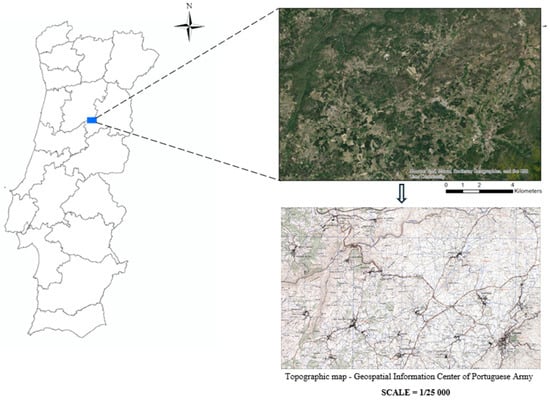
Figure 1.
Location of the study area: rectangular region within the Mondego River basin, which corresponds to the area of sheet number 201 of the M888 cartographic series of the Geospatial Information Center of the Portuguese Army.
The hydrography of the military map at scale 1/25,000, kindly provided by the Army Geospatial Information Center of Portugal, was used as reference data (Figure 2) and has a standard deviation on the planimetric component of 0.97 m [21]. The coverage area of the topographic map is 160 km2. The Shuttle Radar Topography Mission (SRTM) Digital Elevation Model (DEM) georeferenced in the WGS 84 (World Geodetic System 1984) with 90 m of spatial resolution was used. The elevations of these altimetric datasets are georeferenced in Geodetic Reference System 1980 (GRS 80).
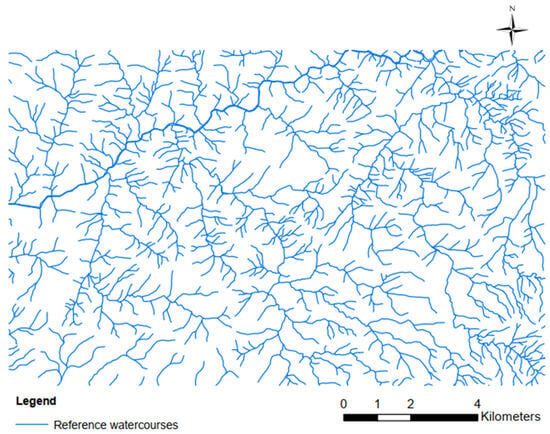
Figure 2.
Reference data—Army Geospatial Information Center Hydrography at 1/25,000 scale.
The region under study is a mountainous region located in the interior of Portugal. The completeness evolution study is quite interesting, and we believe that in this region, even though it is a depopulated region compared to other ones located in Portugal territory, the completeness of geographic entities such as settlements may have a significant evolution in the considered period, but that was not the OSM feature evaluated here. The choice of feature watercourses was supported by the fact that there are few published studies that analyse their completeness, even for watercourses obtained from other sources of datasets. We also considered that this type of feature has some specific characteristics, such as (i) occupying large areas of the territory; (ii) the fact that it can be clearly seen in satellite images, the main support for use by OSM volunteers; (iii) the fact that the smaller water lines (streams) are better identifiable in satellite imagery in rural than in urban areas; and (iv) the fact that these types of lines are part of a network, which means that all segments must be connected to each other.
2.2. Methodology
The OSM waterways (Figure 3) data were extracted in the area covered by sheet number 201 of the M888 cartographic series, in two different moments with a temporal range of nine years, on 14 October 2014 and on 14 November 2023, using the Geofabrik free download server. These data (OSM waterways features) were extracted from the OpenStreetMap platform and were organized in a shapefile format file containing lines georreferenced in the WGS 84 (World Geodetic System 1984), which is subsequently converted (projected) to the Portugal—Transverse Mercator 06—European Terrestrial Reference System 1989 (PT-TM06/ETRS 89), which is the projected coordinate system associated with the reference hydrography data (Figure 2) used in this study and is also the official projected reference coordinate system in Portugal. In the category of water resources, the OSM feature waterway is structured as a key “waterway” with the values, “river”, “riverbank”, “stream”, and “tidal_channel”. However, in this study, we only used the values “river” and “stream”. The first one (“river”) corresponds to a linear flow of a river, in a flow direction. The value “stream” corresponds to a naturally forming waterway that is too narrow to be classed as a river.
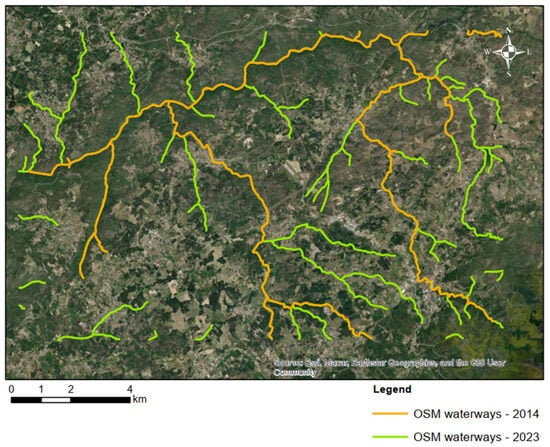
Figure 3.
OSM waterways extracted in the study area in 2014 (orange colour) and in 2023 (green colour), over the satellite image.
The completeness of geographic entities represented on a map or geographic database is a measure obtained from their comparison with the corresponding representation on a reference map or database. Completeness is also a metric or an indicator of coverage of the features (points, lines, and polygons) in terms of mapping representation. We found several methods in the literature to analyse some other OSM features, such as OSM roads and OSM buildings. In this study, the geographic entity of the type of line under analysis is “waterway” and the appropriate method to analyse its completeness is based on the calculation of a value (completeness) obtained from dividing the total length of the lines under analysis () to the total length of the reference lines () and multiplying by 100, according to Equation (1).
The main objective of this study was to analyse the evolution of waterways completeness throughout the period from 2014 to 2023. Firstly, the completeness of waterways of all study areas was calculated for both epochs using Equation (1). After that, two circular-shaped zones were defined randomly within the study area as shown in Figure 4, namely Z1 and Z2 zones. The first one, Z1, with a 2197.5 m radius and the Z2 zone with a 2225.0 m radius, and the waterways completeness was also calculated for both time epochs (2014 and 2023). Then it was possible to analyse the percentual increase in the completeness for all study area and for both zones Z1 and Z2. Further analyses were carried out to understand if there is any relationship between the news’s OSM waterways created and some factors related to terrain (elevation, slope) and land use (location or proximity to settlements). For this purpose, the SRTM Digital Elevation Model (DEM) was used and the slope map with nine slope classes was generated for the study area. Using the SRTM DEM and the slope map, it was possible to analyse the relationship between elevation and slope with the creation of new watercourses. Using the visual interpretation carried out on satellite image, we tried to understand the relationship between the appearance of new OSM’s watercourses and the location/proximity to settlements.
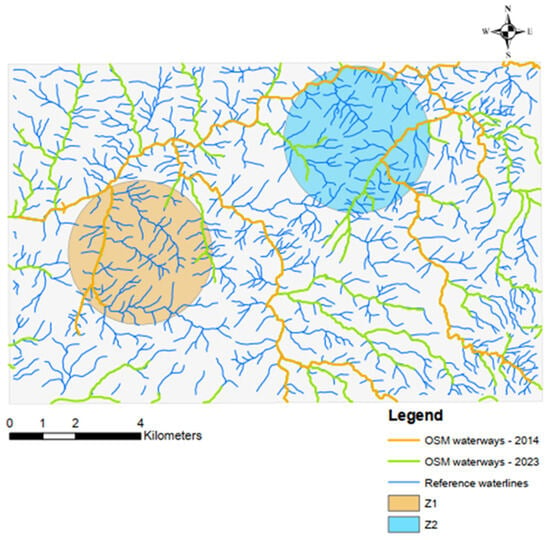
Figure 4.
Z1 (orange colour) and Z2 (blue colour) zones were randomly defined and included in the study area.
3. Results Analysis and Discussion
The study made it possible to analyse the completeness of OSM watercourses considering a temporal separation in the OSM data of nine years. The possible relation of some indicators was also considered when comparing the results obtained in terms of completeness. The proposed methodology can be applied to the study of completeness and its evolution over time for any line-type geographic entity represented on the OSM platform.
3.1. Entire Study Area
In the study area, an increase in OSM watercourses completeness can be observed, as shown in Figure 5. In 2014, only the main OSM rivers were represented. In 2023, it is observed that more OSM watercourses are represented, although they continue to be the main tributaries, as they are those that are best identifiable in satellite images by the volunteer collaborators when they execute the vectorization.
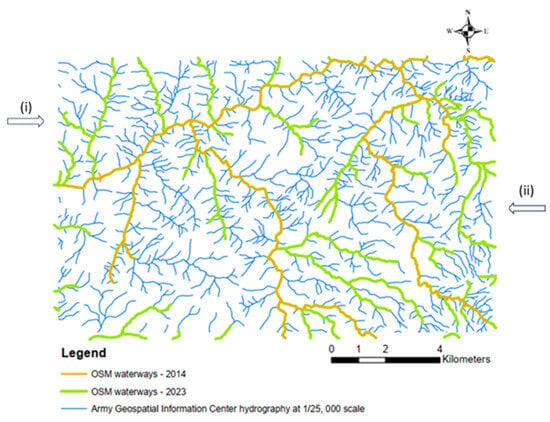
Figure 5.
OSM watercourses extracted in 2014 (orange colour) and 2023 (green colour) and the reference watercourses.
Through visual observation made over satellite images, it is possible to verify that this increase, despite occurring throughout the study area, is more evident in the northern part of the main river (Mondego River) (i) where on the first date considered (2014), no watercourse was represented. It is also clear that in 2023, smaller watercourses will begin to be represented (ii) as can be seen in Figure 5. It is also observed that the watercourses used as reference present greater smoothing than the OSM watercourses, this is because the OSM watercourses are digitized over the satellite image, while the watercourses of the reference were represented cartographically according to photogrammetric methods, which include smoothing and generalization processes for line simplification and subsequent cartographic quality control. It is also possible to observe that the OSM watercourses have connectivity problems, not effectively representing a hydrographic network such as the reference watercourses. This aspect could be a limitation for carrying out processing on the network to obtain sequential hydrological parameters calculations useful for hydrologic modelling.
By analysing OSM watercourses in all study areas in two-time epochs, it can be seen according to Table 1 that there was an increase in completeness (15.4%). In turn, the increase in the representation of rivers was smaller (7 to 9) than the increase in streams (8 to 72).

Table 1.
Total length of watercourses, completeness, number of rivers, and number of streams for both time epochs (2014 and 2023) considered in all study areas.
The topographic parameter total length of reference watercourses, the total length of OSM watercourses in 2014 and 2023, and the corresponding completeness on these two dates are shown in Figure 6.

Figure 6.
Total length of watercourses of the reference drainage network and of OSM watercourses in 2014 and 2023 (left) and completeness values of OSM watercourses in 2014 and 2023 (right).
- (i)
- Elevation
The first indicator that was analysed was the altitude of the terrain. The natural flow of water on the Earth’s surface occurs naturally according to changes in altitude and from points of higher elevation to points of lower elevation. Figure 7 presents the SRTM DEM of the entire study area, and it is possible to observe significant altitude values, with an average value of 655.5 m, or if we were not in a mountain region. When we observe the news’s OSM watercourses (OSM-2023), some of them are in zones of lower altitude, with values that vary between 250 and 500 m. Those areas are close to regions in turn of the main river (Mondego River), but other news’s OSM watercourses are also located in higher regions of the study area with values ranging from 800 and 1095 m (in the southeast part). Thus, these results lead us to believe that altitude does not influence the creation of new watercourses from OSM volunteers. This can be explained by the fact that OSM volunteers create the watercourses using vectorization carried out on satellite images, which strongly depends on good visual interpretation. In relation to this aspect, sometimes, in higher areas, the definition of the watercourses on the satellite image is easier, as the relief itself models the structure of the hydrographic network. At other times, it is in less elevated and flat areas that, based on the vegetation around the watercourses and the occupation of the land on its margins, allow easier identification of the image and its subsequent vectorization, which does not happen with reference watercourses (official military hydrography), because these were obtained from photogrammetric methods that allowed their stereo restitution.

Figure 7.
SRTM Digital Elevation Model of the study area and OSM watercourses extracted in 2014 (orange colour) and 2023 (green colour).
- (ii)
- Slope
We also tried to understand if there is any relation between the slope and the evolution of completeness of the OSM watercourses in that temporal period (nine years). A slope map for all study areas with nine slope classes was created using Shuttle Radar Topography Mission (SRTM) DEM. The slope map (Figure 8) shows that steeper zones are in turn of the main river (Mondego River) and in the southeast part of the study area, with watercourses of minor importance (order), which corresponds to zones of lower and higher elevation, and this is consistent with the morphology of terrain and the natural flow of the water. It is also observed (Figure 8) that the news’s OSM watercourses appear mostly in regions with gentler slopes ([0%, 2.5%], [2.6%, 4.4%], [4.5%, 6.5%], and [6.6%, 8.9%]). However, it can be observed, as we mentioned before, that some small watercourses also appear in areas with steeper slopes in the southeast of the study area ([11.7%, 14.6%], [14.7%, 18.4%], [18.5%, 23.1%], and [23.2%, 32.4%]). These results show that the slope did not influence the creation of new OSM watercourses, which seems natural to us, then the digitalization of OSM watercourses may have been carried out using satellite images that may not have enough perception of the terrain’s slope. Furthermore, the course of a river is clearly visible in the satellite images that are the geospatial product that is used by OSM volunteers, and the waterway feature can be created remotely. It should also be noted that satellite images may contain variations in spatial and temporal resolution, which may make the process of identifying watercourses more difficult, particularly in areas where the slopes of the land are not very steep.
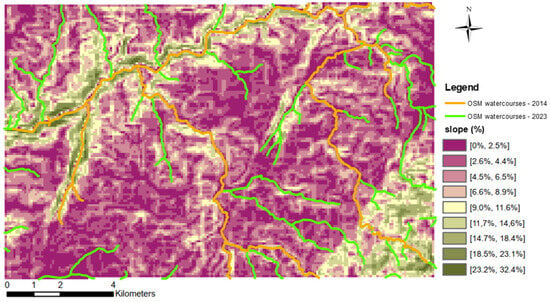
Figure 8.
Slope map of the study area with the representation of OSM watercourses in 2014 (orange colour) and in 2023 (green colour).
- (iii)
- Settlements
In all over the world, the urban zones are the places where most part of people lives.
The completeness of highly populated urban areas is often higher than that of remote and rural areas ([10,17]). Ref. [13] also shows that the size of the urban centers measured by population was positively correlated to completeness. There are also differences between developed and developing countries ([22,23]). These variations in completeness depend on social factors, e.g., population distribution, population density on the earth’s surface, and the location of OSM platform contributors [24].
The study area presents some dispersed and small settlements. When we analyse this indicator (settlements), in an intuitive way, it is believed that it will not have an influence on the completeness of OSM waterways as the completeness of other themes, such as OSM buildings ([25,26,27]), green spaces, roads, and other types of collective equipment located in an urban environment. This is also because the path of a river is adequately visible in satellite images, which is the geospatial product that was used by OSM volunteers, and the feature waterway may be created in a remote way. However, it may happen that in satellite images, spatial and temporal resolution variations may exist, which may make the process of watercourse identification more difficult, particularly in zones where the terrain slopes are not very steep, usually settlement location zones.
Using the visual interpretation carried out on satellite images, it can be seen (Figure 9a) that most OSM watercourses are represented out of settlements (rural areas). However, it should be noted that this does not happen on the north bank of the main river, the Mondego River, marked with white arrows, where OSM watercourses (of three main tributaries) across settlements, exemplified with more detail the case of western settlement (Figure 9b).
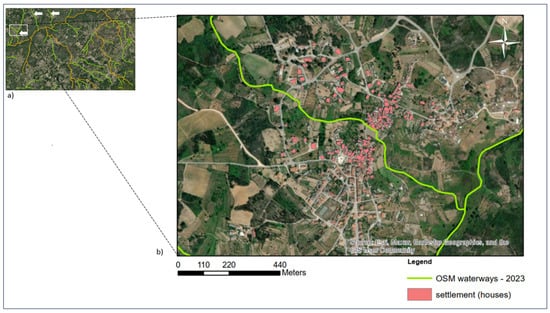
Figure 9.
News’s OSM waterways (extracted in 2023—green colour) crossing some settlements in the north bank of Mondego River (a) and a detailed image exemplifying the western settlement crossed (b).
3.2. Z1 and Z2 Zones
When we analyse the completeness of both zones (Figure 4) defined for the same epochs (2014 and 2023), the obtained results are slightly different (Table 2 and Table 3). The results of the Z1 zone of total length, completeness, number of rivers, and number of streams are presented in Table 2 and show an increase in completeness of 7.9%, a value lower than the value obtained for the entire study area, which was 15.4%. In terms of the number of rivers, there was no variation, but the streams increased from 2 to 5.

Table 2.
Total length, completeness, number of rivers, and number of streams of OSM watercourses in Z1 zone.

Table 3.
Total length, completeness, number of rivers, and number of streams of OSM watercourses in the Z2 zone.
In the Z2 zone, the increase in completeness was 13.6%, a value greater than that corresponding to the Z1 zone but still lower than the value obtained for the entire study area (15.4%). The number of OSM rivers increased from 1 to 3, and OSM streams from 2 to 6 (Table 3). It can also be observed that the total length of reference watercourses in the Z2 zone (69,784 m) is greater than the total length of reference watercourses in the Z1 zone (64,414 m).
Figure 10 presents the reference watercourses and the OSM waterways represented in both time epochs for the Z1 zone. As can be observed in 2023, the new watercourses created are in the east part of the Z1 zone.
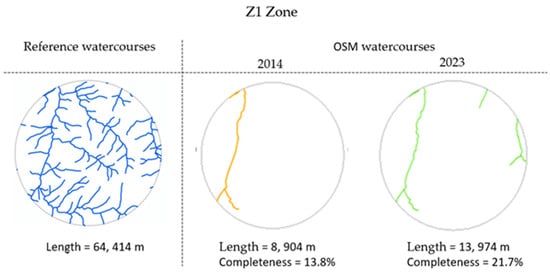
Figure 10.
Reference watercourses and OSM watercourses in the Z1 zone in 2014 and 2023.
In the Z2 zone, the new watercourses are distributed in the south and west parts of that zone (Figure 11). As we mentioned before, we may observe that many more reference watercourses exist in Z2 than in Z1 and the increase in OSM watercourse completeness is also higher in Z2 than Z1 zone, showing some coherence.
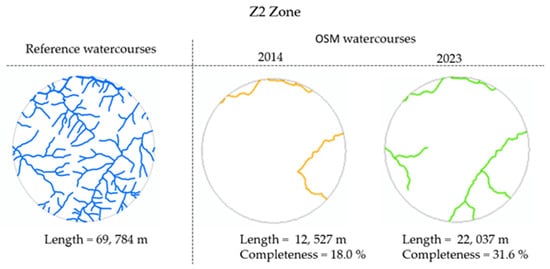
Figure 11.
Reference watercourses and OSM watercourses in the Z2 zone in 2014 and 2023.
Considering the SRTM DEM of the Z1 zone, we verified that the news’s OSM watercourses are represented in regions with elevation values belonging to the range [385 m, 461 m] (Figure 12). In the Z2 zone, the news’s OSM watercourses represented are located at altitudes between values belonging to the range [357 m, 376 m], [371 m, 418 m], and [358 m, 407 m], as may be seen in Figure 12. In other words, we believe that altitude does not influence the appearance of new OSM watercourses. This can be explained by the fact that the watercourse is a linear and continuous geographic entity that develops throughout physical space and naturally develops precisely according to the variation in altitude indicator, and the springs are in regions of high altitude; as the river develops, it reaches lower altitudes.
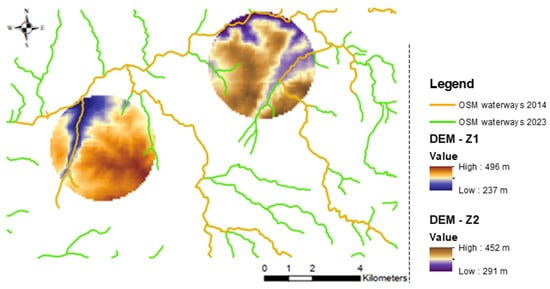
Figure 12.
Completeness of OSM waterways (in 2014 and 2023) versus terrain altitude (DEM) in Z1 (left) and Z2 (right) zones.
As we did before, for the entire study area, with respect to the Z1 and Z2 zones, we will analyze the possible influence of slope on the evolution of OSM watercourses completeness. In the Z1 zone, the news’s OSM watercourses appear at slopes with values belonging to the ranges [0.0%, 2.4%]; [5.8%, 7.7%], and [7.8%, 9.9%] (Figure 13). In the Z2 zone, the news’s OSM watercourses represented are in areas with slope values belonging to the ranges [0.0%, 2.4%]; [2.5%, 4.0%]; and [7.8%, 9.9%] (Figure 13).
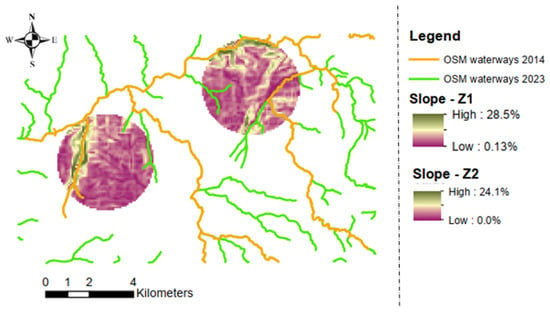
Figure 13.
Completeness of OSM waterways (in 2014 and 2023) versus terrain slope in Z1 (left) and Z2 (right) zones.
By analysing the evolution of completeness during the period under study in the Z1 zone, it is observed that the news’s OSM waterways do not cross settlements, despite being located relatively close together in the northeast and east part of the Z1 zone, marked by red balls, as can be seen in Figure 14.
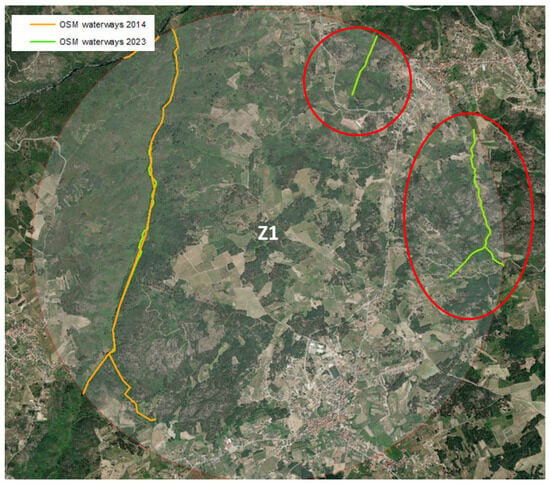
Figure 14.
New’s OSM waterways (2023) in northeast and east part of Z1 zone.
In zone Z2, as can be seen in Figure 15, the news’s OSM watercourses are in the western and southern regions (marked by red balls) and do not cross any settlement, despite the new watercourses located there (southern part of Z2) being considerably close to a village and develop linearly and almost parallel to the agglomeration. Regarding this indicator, we also cannot find a relation between the news’s OSM waterways created and the location or proximity of settlements; thus, if in the Z1 zone, the news lines are relatively close to settlements. In the Z2 zone, some of them are relatively close to settlements, but others are far away from them. We think that if we had studied other areas defined and inserted in the study area, we could eventually have more concrete analyses, although we know in advance that throughout the study area, no relationship was observed between the new OSM watercourses and the settlements.
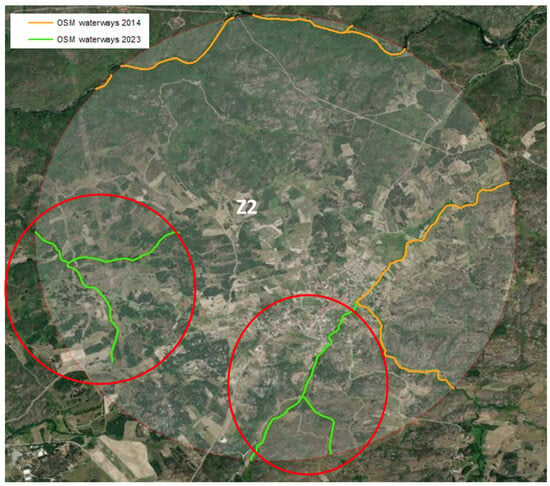
Figure 15.
New’s OSM waterways (2023) in western and south part of Z2 zone.
4. Conclusions
The completeness of OSM data has been studied and published by numerous authors; however, in relation to the topic of watercourses, it is difficult to find publications of studies and works developed that address the topic. In this study, the evolution of the completeness of watercourses extracted from OpenStreetMap in two epochs nine years apart was analysed. This feature type is usually developed in an extensive dimension of land surface; then, we considered that the reference data used (1/25,000 scale) ensures the comparison of OSM waterways in terms of completeness.
The methodology was applied to an area located in a rural and mountainous region located in the center of Portugal. The completeness of OSM watercourses across the entire study area increased by 15.4%. It is believed that it is a low value considering the nine years apart and the availability that exists today, through mobile devices with internet access, to use platforms for accessing satellite images with increasingly greater spatial resolution.
Ref. [10] carried out a study in 2013 to analyse the OMS building completeness in an urban region in Germany over a period of one year. They concluded that OSM building completeness had an increase of about 8% during that year. Furthermore, we know that urban dynamics mean that the completeness of this type of feature (buildings) must be faster than the natural feature studied here (riverway), but it must also be emphasized that the period under analysis is much shorter (1 year) than the period studied here (9 years). In addition, in that period of nine years, the number of OSM contributors also increased in a significative way. Although reference values for variation in completeness over time for this feature (waterway) are not found in the literature, we consider that the increase in completeness of the OSM waterways was low.
Due to the specificity of this geographic entity, we also tried to analyse the relation between the location of new watercourses and some indicators, such as elevation, slope, and location or proximity to settlements. When analysing the completeness of the study area and the possible relation with the elevation indicator, we observe that the news’s OSM watercourses drawn appear not only in the lower altitude regions but also in the higher altitude regions. The results show that the creation of this feature is not related to altitude in an apparent way. One reason that may contribute to this fact is that within the study area, there are extensive areas covered by rocks; hence, it is difficult to identify the watercourses with this type of land cover. The indicator slope of the terrain also does not seem to be related to the representation of the news’s OSM watercourses. The results show that some of the news’ watercourses are in the lower slope regions, but other ones are in higher slope regions. Another factor (indicator) that contributes to the good interpretation of OSM watercourses in a satellite image and the consequent digitalization by OSM volunteers is the land cover, which we did not analyse here, but we know that may influence the creation of this OSM feature. Sometimes, the presence of vegetation helps to define watercourses, but at other times, it makes things more difficult in his definition. However, neither indicators related to land cover (presence of rock and vegetation) were analysed in this study.
Finally, we tried to relate the completeness of OSM waterways with the settlement’s locations or the settlement’s proximity. We already mentioned that some published studies conclude that the completeness of other OSM features, such as buildings and other objects located in urban environments, is influenced and correlated positively by the presence of people that live in these areas, particularly the OSM contributors, but, with this OSM feature (waterway), that did not happen. Here, we verified that most new watercourses are represented in non-urbanized (natural and rural) areas, although some of them are near of some settlements. Another detailed analysis was carried out in two zones defined randomly, and we did not observe a relation between the creation of news’s OSM watercourses and those indicators.
Another future research direction will be to analyse the application of the same methodology to an area of the same size, in the same country, or another one, but in a non-urban area and using OSM data extracted in the same epochs (2014 and 2023), which will allow us to analyse the relation of the same indicators to OSM watercourses completeness, particularly verifying whether the presence of people may influence the representation of this OSM feature. Other indicators may be added to this methodology such as some related to land cover characteristics of terrain, namely, vegetation or the existence of rocks.
Author Contributions
Conceptualization, E.S.V.M. and G.R.P.; methodology, E.S.V.M.; software, E.S.V.M.; validation, E.S.V.M. and G.R.P.; formal analysis, E.S.V.M. and G.R.P.; investigation, E.S.V.M. and G.R.P.; resources, E.S.V.M. and G.R.P.; writing—original draft preparation, E.S.V.M.; writing—review and editing, E.S.V.M. and G.R.P. All authors have read and agreed to the published version of the manuscript.
Funding
This work was supported by the Portuguese Foundation for Science and Technology under the project grant: (i) UID/05488/2020 and (ii) UIDB/00308/2020 (with the DOI 10.54499/UIDB/00308/2020).
Data Availability Statement
Data are contained within the article.
Acknowledgments
The authors thank the Army Geospatial Information Center (Portugal) for making the hydrography of the military map 1/25,000 available that was used in the study as reference data.
Conflicts of Interest
The authors declare no conflicts of interest.
References
- Bao, L.; Lv, X.; Yao, J. Water Extraction in SAR Images Using Features Analysis and Dual-Threshold Graph Cut Model. Remote Sens. 2021, 13, 3465. [Google Scholar] [CrossRef]
- Jiang, H.; Feng, M.; Zhu, Y.; Lu, N.; Huang, J.; Xiao, T. An Automated Method for Extracting Rivers and Lakes from Landsat Imagery. Remote Sens. 2014, 6, 5067–5089. Available online: www.mdpi.com/journal/remotesensing (accessed on 29 May 2024). [CrossRef]
- Al-Bakri, M.; Fairbairn, D. Assessing the accuracy of ‘Crowdsourced’ data and its integration with official spatial datasets. In Proceedings of the Accuracy 2010 Symposium, Leicester, UK, 20–23 July 2010; pp. 317–320. [Google Scholar]
- Biljecki, F.; Chow, Y.S.; Lee, K. Quality of crowdsourced geospatial building information: A global assessment of OpenStreetMap attributes. Build. Environ. 2023, 237, 110295. [Google Scholar] [CrossRef]
- Girres, J.F.; Touya, G. Quality assessment of the french OpenStreetMap dataset. Trans. GIS 2010, 14, 435–459. [Google Scholar] [CrossRef]
- ISO 19157; Geographic Information–Data Quality. ISO: Geneva, Switzerland, 2013; 146p.
- Barrington-Leigh, C.; Millard-Ball, A. The world’s user-generated road map is more than 80% complete. PLoS ONE 2017, 12, e0180698. [Google Scholar] [CrossRef] [PubMed]
- Goodchild, M.F. Geographic Information Systems and Science: Today and tomorrow. Ann. GIS–Taylor Fr. 2009, 15, 3–9. [Google Scholar] [CrossRef]
- Chen, Y.; Wei, Z. Assessing completeness of global airport data in OSM. Advances in Cartography and GIScience of the International Cartographic Association. In Proceedings of the 31st International Cartographic Conference (ICC 2023), Cape Town, South Africa, 13–18 August 2023. [Google Scholar]
- Hecht, R.; Kunze, C.; Hahmann, S. Measuring Completeness of Building Footprints in OpenStreetMap over Space and Time. ISPRS Int. J. Geo-Inf. 2013, 2, 1066–1091. [Google Scholar] [CrossRef]
- Brovelli, M.A.; Zamboni, G.A. New Method for the Assessment of Spatial Accuracy and Completeness of OpenStreetMap Building Footprints. ISPRS Int. J. Geo-Inf. 2018, 7, 289. [Google Scholar] [CrossRef]
- Ullah, T.; Lautenbach, S.; Herfort, B.; Reinmuth, M.; Schorlemmer, D. Assessing Completeness of OpenStreetMap Building Footprints Using MapSwipe. Int. J. Geoinf. 2023, 12, 143. [Google Scholar] [CrossRef]
- Herfort, B.; Lautenbach, A.; Albuquerque, J.P.; Anderson, J.; Zipf, A. A spatio-temporal analysis investigating completeness and inequalities of global urban building data in OpenStreetMap. Nat. Commun. 2023, 14, 3985. [Google Scholar] [CrossRef]
- Yeboah, G.; Porto de Albuquerque, J.; Troilo, R.; Tregonning, G.; Perera, S.; Ahmed, S.A.K.S.; Ajisola, M.; Alam, O.; Aujla, N.; Azam, S.I.; et al. Analysis of OpenStreetMap Data Quality at Different Stages of a Participatory Mapping Process: Evidence from Slums in Africa and Asia. ISPRS Int. J. Geo-Inf. 2021, 10, 265. [Google Scholar] [CrossRef]
- Neis, P.; Zielstra, D.; Zipf, A. The Street Network Evolution of Crowdsourced Maps: OpenStreetMap in Germany 2007–2011. Future Internet 2012, 4, 1–21. [Google Scholar] [CrossRef]
- Jackson, S.P.; Mullen, W.; Agouris, P.; Crooks, A.; Croitoru, A.; Stefanidis, A. Assessing Completeness and Spatial Error of Features in Volunteered Geographic Information. ISPRS–Int. J. Geo-Inf. 2013, 2, 507–530. [Google Scholar] [CrossRef]
- Brückner, J.; Schott, M.; Zipf, A.; Lautenbach, S. Assessing shop completeness in OpenStreetMap for two federal states in Germany. AGILE GIScience Ser. 2021, 2, 20. [Google Scholar] [CrossRef]
- Wang, S.; Zhou, Q.; Tian, Y. Understanding Completeness and DiversityPatterns of OSM-Based Land-Use and Land Cover Dataset in China. ISPRS–Int. J. Geo-Inf. 2020, 9, 531. [Google Scholar] [CrossRef]
- Barron, C.; Neis, P.; Zipf¸, A. A Comprehensive Framework for Intrinsic OpenStreetMap Quality Analysis. Trans. GIS 2014, 6, 877–895. [Google Scholar] [CrossRef]
- Sampaio, T.V.M.; Rocha, J. On the Quality of the drainage network cartographic representation. Ecol. Indic. 2022, 143, 109350. [Google Scholar] [CrossRef]
- Afonso, A.; Lopes, J.; Dias, R. Controlo de Qualidade Posicional da Cartografia Militar do IGeoE em ETRS89. Report of IGeoE 2010, 5p. Available online: http://www.igeoe.pt/downloads/file2_pt.pdf (accessed on 30 May 2024).
- Herfort, B.; Lautenbach, S.; Porto de Albuquerque, J.; Anderson, J.; Zipf, A. The evolution of humanitarian mapping within the OpenStreetMap community. Sci. Rep. 2021, 11, 3037. [Google Scholar] [CrossRef]
- Herfort, B.; Lautenbach, S.; de Albuquerque, J.P.; Anderson, J.; Zipf, A. Investigating the digital divide in OpenStreetMap: Spatio-temporal analysis of inequalities in global urban building completeness. Res. Sq. 2022; preprint. [Google Scholar] [CrossRef]
- Quattrone, G.; Mashhadi, A.; Capra, L. Mind the map: The impact of culture and economic affluence on crowd-mapping behaviours. In Proceedings of the 17th ACM Conference on Computer Supported Cooperative Work & Social Computing-CSCW ‘14, Baltimore, MD, USA, 15–19 February 2014; ACM Press: Baltimore, MD, USA, 2014; pp. 934–944. [Google Scholar]
- Zhou, Q.; Zhang, Y.; Chang, K.; Brovelli, M.A. Assessing OSM building completeness for almost 13,000 cities globally. Int. J. Digit. Earth 2022, 15, 2400–2421. [Google Scholar] [CrossRef]
- Borkowska, S.; Bielecka, E.; Pokonieczny, K. OpenStreetMap–building data completeness visualization in terms of “Fitness for purpose”. Adv. Geod. Geoinf. 2023, 72, 2023. [Google Scholar] [CrossRef]
- Zhang, Y.; Zhou, Q.; Brovelli, M.A.; Li, W. Assessing OSM Building Completeness Using Population Data. Int. J. Geogr. Inf. Sci. 2022, 36, 1443–1466. [Google Scholar] [CrossRef]
Disclaimer/Publisher’s Note: The statements, opinions and data contained in all publications are solely those of the individual author(s) and contributor(s) and not of MDPI and/or the editor(s). MDPI and/or the editor(s) disclaim responsibility for any injury to people or property resulting from any ideas, methods, instructions or products referred to in the content. |
© 2024 by the authors. Licensee MDPI, Basel, Switzerland. This article is an open access article distributed under the terms and conditions of the Creative Commons Attribution (CC BY) license (https://creativecommons.org/licenses/by/4.0/).